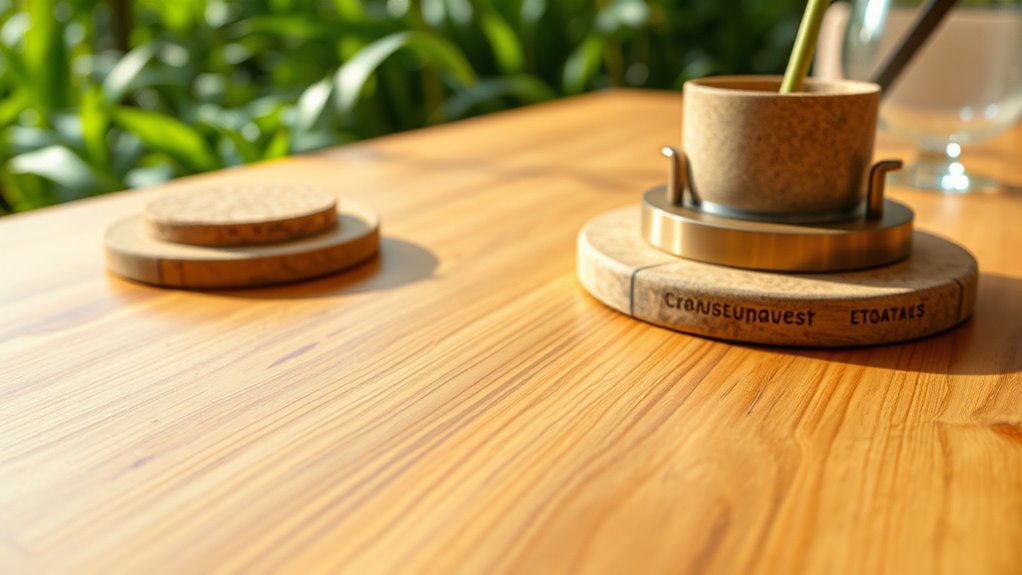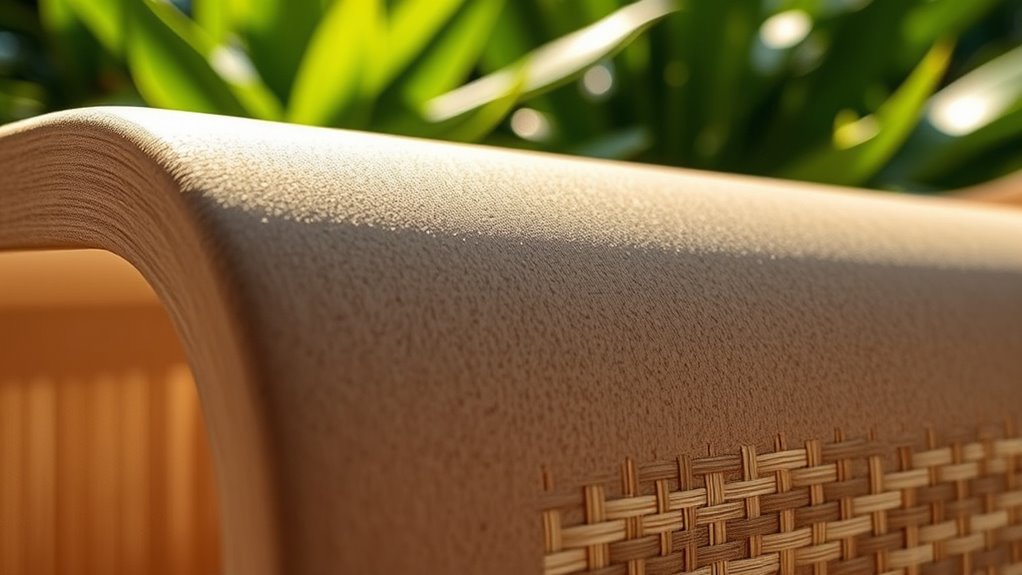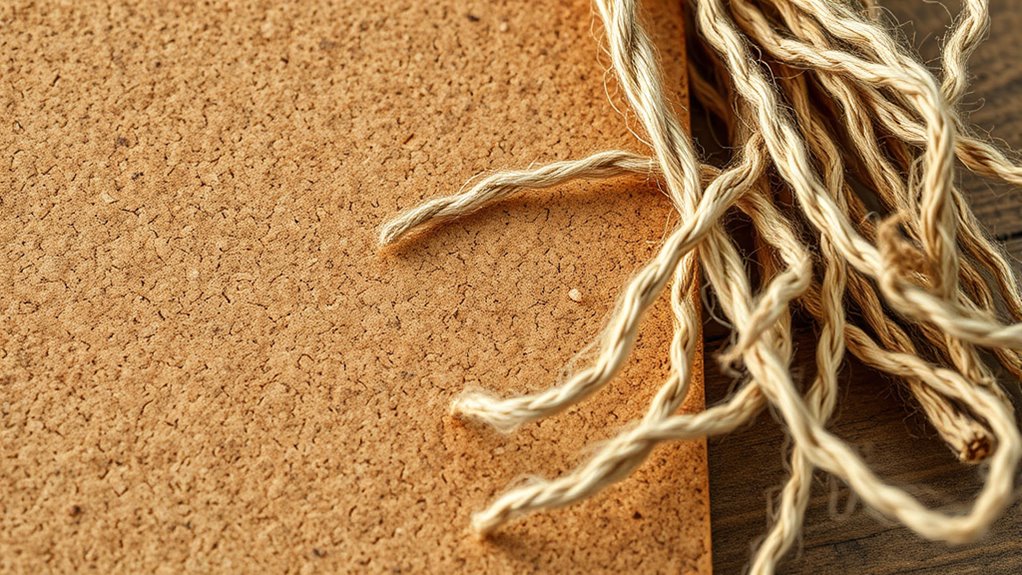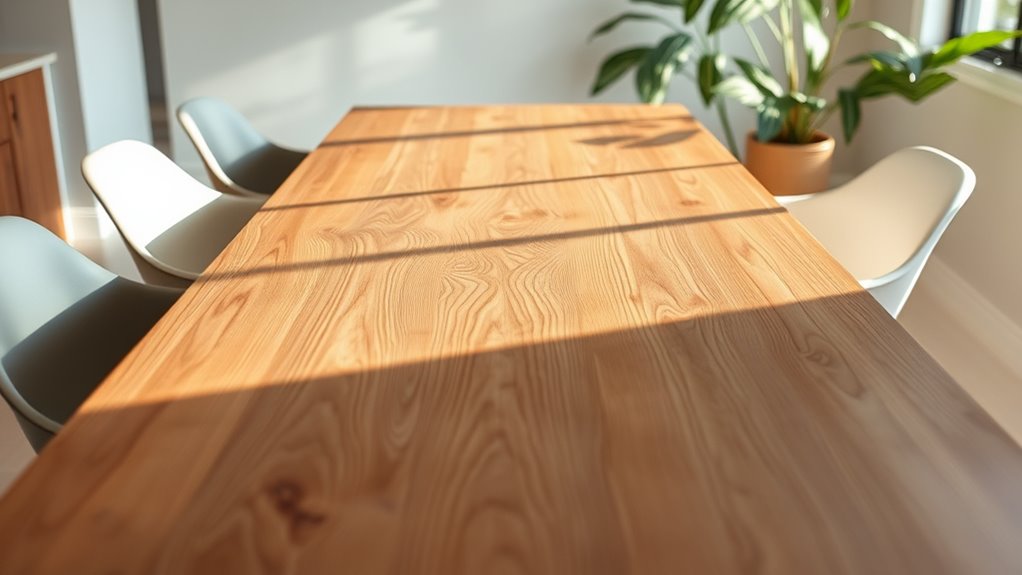Eco-friendly furniture materials focus on sustainability and reducing environmental impact. You can choose options like responsibly sourced or reclaimed wood, recycled metals and plastics, or plant-based composites made from hemp, bamboo, or jute. Natural fibers like cork, rattan, and bamboo grow quickly and support biodiversity. Plus, eco-finishings with low VOCs help keep indoor air healthy. If you want to discover more about eco-conscious choices, you’ll find plenty of insightful details below.
Key Takeaways
- Eco-friendly furniture uses sustainable, reclaimed, or recycled materials like wood, metals, plastics, and fibers to reduce environmental impact.
- Natural fibers such as bamboo, rattan, cork, and jute are renewable, biodegradable, and add organic aesthetic appeal.
- Reclaimed wood and certified timber support responsible forestry while minimizing waste and deforestation.
- Eco-conscious finishes with low-VOC and non-toxic options improve indoor air quality and safety.
- Innovative materials like plant-based composites and recycled plastics promote circular economy principles in furniture making.
Sustainable Wood Options

Sustainable wood options provide an eco-friendly alternative to traditional timber, helping reduce deforestation and conserve natural resources. Forest certification plays a key role, ensuring that the wood comes from responsibly managed forests that meet environmental and social standards. When you choose certified wood, you’re supporting sustainable forestry practices that protect biodiversity and local communities. Reclaimed lumber is another excellent option, as it repurposes wood from old buildings, barns, and other structures, giving it a second life. This not only minimizes waste but also reduces the demand for fresh timber. By opting for these sustainable choices, you contribute to reducing your carbon footprint and promoting responsible consumption, making your furniture environmentally friendly without sacrificing style or quality.
Recycled Metals and Plastics

Recycled metals and plastics are excellent choices for eco-friendly furniture because they reduce waste and lower the demand for virgin materials. Metal recycling transforms scrap into durable components, cutting down on mining and energy use. By repurposing metals like aluminum and steel, you help conserve natural resources and minimize environmental impact. Plastic repurposing involves transforming discarded plastics into new furniture parts, preventing plastics from ending up in landfills or oceans. This process not only diverts waste but also reduces the need for virgin plastic production, which is energy-intensive. Incorporating recycled metals and plastics into furniture designs offers a sustainable alternative that promotes circular economy principles. You benefit from sturdy, stylish pieces while contributing to environmental preservation through responsible material choices. Recycling processes ensure that materials are efficiently transformed into high-quality, durable components suitable for furniture making.
Plant-Based Composites

Plant-based composites use fibers like hemp, bamboo, and jute to create strong, lightweight materials for furniture. The manufacturing process often involves binding these fibers with eco-friendly resins or adhesives. These composites offer significant environmental benefits by reducing reliance on synthetic materials and lowering carbon footprints.
Types of Plant Fibers
Have you ever wondered what makes plant fibers a popular choice for eco-friendly furniture? It’s their natural durability and versatility. When fiber processing is done right, these fibers become sturdy and resilient, perfect for long-lasting pieces. Here are four key types you should know:
- Hemp – Known for its strength and eco-friendliness, it offers excellent durability.
- Jute – Lightweight and biodegradable, ideal for softer furniture accents.
- Sisal – Tough and stiff, perfect for textured surfaces and rugs.
- Flax (Linen) – Smooth, breathable, and durable, it adds elegance to furniture.
These plant fibers combine natural durability with sustainable fiber processing, making them a smart, eco-conscious choice for your furniture needs. Content quality and topical authority are essential in promoting trusted and sustainable materials.
Manufacturing Processes Involved
Manufacturing plant-based composites involves combining natural fibers with eco-friendly resins or binders to create durable, sustainable materials for furniture. This process balances traditional craftsmanship with modern mass production techniques. Skilled artisans often handcraft the initial components, ensuring quality and attention to detail. When scaling up, automated machinery and standardized procedures help produce consistent, large quantities efficiently. The fibers are carefully processed and aligned, then bonded with eco-friendly resins under controlled conditions. This combination results in resilient panels that can be shaped into furniture pieces. Using sustainable materials and eco-conscious methods throughout manufacturing minimizes environmental impact. Proper preparation and use of materials are crucial for achieving optimal quality and performance. By blending traditional skills with innovative production, you can create eco-friendly furniture that’s both artisanal and suitable for mass markets.
Environmental Benefits Highlighted
Did you know that using plant-based composites in furniture production considerably reduces environmental impact? These materials offer significant benefits that directly affect our planet’s health. They enhance air purification by filtering pollutants naturally, creating healthier indoor spaces. They promote carbon sequestration, capturing carbon dioxide from the atmosphere and reducing greenhouse gases. They require less energy during manufacturing, lowering carbon emissions. They support sustainable farming, conserving resources and promoting biodiversity. Additionally, employing ethical hacking principles in manufacturing processes can help identify vulnerabilities in supply chains, ensuring sustainable practices are maintained throughout production.
Bamboo and Rattan

Bamboo and rattan grow quickly, making them excellent choices for eco-friendly furniture. They’re renewable and sustainable resources that reduce environmental impact. Plus, their natural textures add a unique and appealing look to any space. Incorporating sustainable materials like bamboo and rattan can also help minimize the use of non-renewable resources.
Rapid Growth Rates
Because of their rapid growth rates, bamboo and rattan are highly sustainable choices for eco-friendly furniture. Their quick renewal makes them ideal amid urban expansion and deforestation concerns. You can feel confident choosing these materials, knowing they don’t deplete forests or take decades to mature. Here are four reasons why they stand out:
- They grow up to 35 inches in a single day, providing a quick renewable resource.
- Bamboo can be harvested every 3–5 years without damaging the plant.
- Rattan’s natural vines regenerate rapidly, reducing environmental impact.
- Their fast growth helps absorb carbon dioxide, fighting climate change.
- Ensuring proper wood stove safety standards during processing helps maintain their eco-friendly benefits.
Renewable and Sustainable
As renewable resources, bamboo and rattan offer sustainable solutions for eco-friendly furniture. They grow quickly, making them ideal for urban farming initiatives that promote local, sustainable sourcing. Bamboo, in particular, absorbs carbon dioxide efficiently, helping reduce your carbon footprint. Rattan’s natural flexibility allows for versatile furniture designs, reducing waste during manufacturing. Both materials are biodegradable, so they break down naturally without polluting the environment. Using bamboo and rattan supports eco-conscious practices like minimizing reliance on non-renewable resources and reducing packaging waste. Additionally, the growth rate of bamboo makes it one of the fastest-renewing plants, ensuring a steady supply for sustainable furniture production. Opting for furniture made from these materials encourages the use of biodegradable packaging, further decreasing environmental impact. By choosing bamboo and rattan, you contribute to a cycle of sustainability, ensuring resources are replenished and waste is minimized.
Unique Aesthetic Appeal
The natural textures and warm tones of bamboo and rattan instantly add visual interest and character to any space. Their unique aesthetic appeal stems from their ability to showcase artistic expression and cultural significance. When you incorporate these materials, you connect with centuries-old craftsmanship and traditions. Their versatile look evokes feelings of calm and authenticity. Here are four reasons why they enhance your space emotionally:
- They evoke a sense of tradition and heritage.
- Their organic textures create a cozy, inviting atmosphere.
- Their natural imperfections tell a story of craftsmanship.
- They inspire creativity by blending artistry with functionality.
Choosing bamboo and rattan allows you to celebrate cultural significance while adding a distinctive, eye-catching charm to your home.
Cork and Natural Fibers

Cork and natural fibers offer sustainable alternatives for eco-friendly furniture. Cork harvesting involves stripping bark from cork oak trees without harming them, enabling continuous bark renewal and reducing environmental impact. This process makes cork a renewable resource that absorbs carbon dioxide and supports biodiversity. Natural fiber sourcing includes materials like jute, hemp, and sisal, which are cultivated with minimal chemical use and have low water requirements. These fibers are biodegradable, renewable, and often require less energy to produce than synthetic options. Using cork and natural fibers in furniture design not only minimizes ecological footprints but also promotes responsible resource management. Additionally, these materials are often biodegradable, which further reduces their environmental impact. By choosing products made from these materials, you help support sustainable practices while enjoying durable, stylish furniture options.
Low-VOC and Non-Toxic Finishes

Building on the eco-friendly benefits of cork and natural fibers, choosing low-VOC and non-toxic finishes enhances the sustainability of your furniture. These finishes improve chemical safety and markedly boost indoor air quality, making your space healthier. When selecting finishes, consider:
- Reduced toxic fumes, protecting your family’s health
- Safer environment, minimizing chemical exposure
- Cleaner indoor air, preventing respiratory issues
- Eco-conscious choice, supporting sustainable living
- Incorporating empathy and understanding into your decision-making process can foster a more mindful and health-conscious environment.
Innovative Eco-Friendly Materials

As innovation drives the development of eco-friendly furniture, manufacturers now incorporate sustainable materials that are both functional and environmentally responsible. You’ll find new options like bamboo, reclaimed wood, and recycled plastic, all gaining popularity due to their eco friendly certifications. These certifications ensure the materials meet strict environmental standards, giving you peace of mind about their sustainability. Additionally, companies are adopting biodegradable packaging, reducing waste and pollution. These innovations help you make greener choices without sacrificing style or durability. By choosing furniture made with these innovative eco-friendly materials, you support sustainable practices and lessen your environmental footprint. It’s a simple way to enjoy beautiful furniture while contributing to a healthier planet.
Frequently Asked Questions
How Does the Durability of Eco-Friendly Materials Compare to Traditional Options?
You might wonder how eco-friendly materials hold up over time compared to traditional options. Generally, eco-friendly materials offer good material longevity, but it can vary. They often require less maintenance, which helps preserve their durability. While some eco-friendly options might be less resistant initially, many are designed to be durable and sustainable. So, with proper care, eco-friendly furniture can match or even surpass traditional materials in longevity.
Are Eco-Friendly Furniture Materials More Cost-Effective Long-Term?
Think of eco-friendly furniture materials like planting a tree—you might spend more upfront, but over time, the shade and fruit save you money. Yes, they often have better material longevity, reducing replacement costs. This translates to significant cost savings in the long run, making eco-friendly options more economical. Investing in durable, sustainable materials guarantees your furniture lasts longer and saves you money over time.
What Certifications Verify the Sustainability of These Materials?
You might ask which certifications verify the sustainability of eco-friendly furniture materials. Certification standards like FSC for wood, GREENGUARD for low emissions, and Rainforest Alliance for responsible sourcing, guarantee sustainability labels confirm eco-friendliness. These labels help you identify genuinely sustainable materials, so you can make informed choices. Always look for recognized certifications to guarantee the furniture’s environmental impact aligns with your values and supports responsible manufacturing practices.
Can Eco-Friendly Materials Be Recycled or Repurposed Easily?
You might wonder if eco-friendly materials can be recycled or repurposed easily. While many are designed with reuse potential in mind, recycling challenges still exist, like limited facilities or material degradation. However, you can often repurpose or recycle these materials more sustainably than traditional ones, helping to reduce waste. Your efforts in choosing recyclable or reusable eco-friendly options contribute to a more sustainable future, even if some challenges remain.
How Do Eco-Friendly Materials Impact Indoor Air Quality Over Time?
Imagine a world where your furniture is as fresh as a 1920s speakeasy. Eco-friendly materials can positively impact indoor air quality by reducing VOC emissions over time. They often emit fewer toxins, helping with air purification and creating a healthier living space. You’ll breathe easier, knowing your furniture isn’t contributing to indoor pollution, and it supports a more sustainable environment. This makes your home safer and more comfortable for everyone.
Conclusion
Choosing eco-friendly furniture materials helps protect the planet for future generations. From sustainable woods to plant-based composites, each option reduces environmental impact without sacrificing style or durability. Remember, a little goes a long way—”You are what you eat,” and in this case, what you choose to furnish your home with reflects your commitment to sustainability. Make informed choices today, and contribute to a greener tomorrow.









